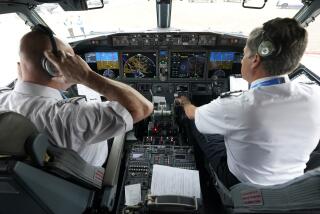Thanks to Airline Program, Thousands Now Take Off : Conquering Fear of Flying--by the Book
- Share via
PITTSBURGH, Pa. — After more than three years of being grounded by dread, a nervous but determined Phil DeHart boarded a plane a few days before Christmas so he could spend the holiday with relatives in Indiana.
He wouldn’t have been able to get on that jet, he says, if it weren’t for a new book designed to ease fearful fliers’ fears.
“The book tells you, ‘The more you understand something, the less you fear it.’ I think that’s one of the things that helped me,” the 35-year-old painting contractor said.
“Fly Without Fear,” a 172-page psychology paperback written by the directors of USAir’s Fearful Flyers Program, is helping countless others cope with aerophobia, or just plain apprehension. Studies show that 1 in 6 Americans is afraid to fly, making it one of the two or three things people fear most.
“It’s the next best thing to the class that we do,” said Capt. Frank Petee, a former pilot who is director of special projects for USAir.
Petee and Carol Stauffer, a clinical social worker, based “Fly Without Fear” on the seven-week program they launched here in 1975. Some 3,000 people have taken the course, and 97% of them report success.
The course is offered in only 10 U.S. cities a year so “when we get a call from someone in Minnesota and they’re desperate like these people are, there’s nothing to offer them,” Stauffer said. “Now they have a book.”
One person helped by the course was Patricia Hass, an editor at Dodd, Mead & Co., who asked them to write the book. Dodd, Mead released it in November but Petee and Stauffer have taken over distribution from the liquidating publisher.
Like the program, “Fly Without Fear” describes the mechanics of flying and the reason for turbulence. It also discusses the four main fears of flying: acrophobia, or fear of heights; claustrophobia, or fear of closed spaces; fear of crashing or dying, and fear of not being in control. It suggests relaxation techniques and other methods to overcome them.
The book also emphasizes air safety. An average 18,000 commercial flights carry 1 million people daily in the United States, generally without incident, Stauffer said. “It’s by far the safest way one can travel.”
Knowing the odds as well as something about the process of flying comforted DeHart during a week that unnerved even the most fearless fliers.
After twice poring over “Fly Without Fear,” DeHart flew Dec. 21 from his home in Phoenix to Indianapolis. That was a few hours before a bomb aboard Pan American World Airways Flight 103 exploded in the sky over Scotland.
He returned Dec. 26--the day an Eastern Airlines Boeing 727 was forced to land in Charleston, W.Va., with a 14-inch hole torn in its fuselage.
That is bad timing for anyone but especially for someone whose fear stemmed from the misfortune of being at airports within a few hours or days of crashes.
DeHart passed through Dallas-Ft. Worth International Airport on Aug. 3, 1985, a day after a Delta Air Lines jumbo jet crashed, killing 137 people. “I could see all the wreckage out there,” he said.
“I made a vow to myself I wasn’t going to get on another airplane.”
Accidents tend to push “borderline” fearful fliers over the edge, said Stauffer. “It’s just so awesome to think about. If you already have some fear inside you, brewing there, something like that is enough to set it off.”
Petee acknowledges that his job undoubtedly will be “tougher from here on in” because of the Pan Am bombing and recent accidents.
“Quite often, you have to revert back to the fact that these things happening like this are so far and few between. They really are,” he said. “When you go back 25 to 30 years, only 2% of accidents were caused by maintenance-related incidents. Only 2%.”
More to Read
Sign up for our Book Club newsletter
Get the latest news, events and more from the Los Angeles Times Book Club, and help us get L.A. reading and talking.
You may occasionally receive promotional content from the Los Angeles Times.









